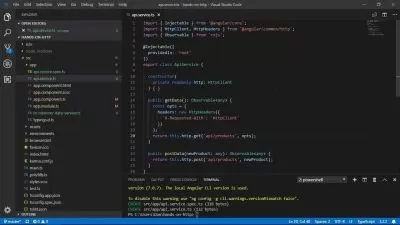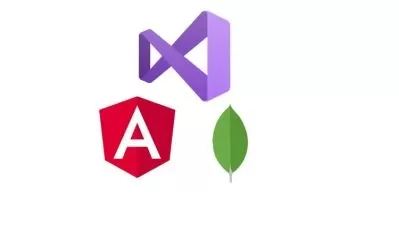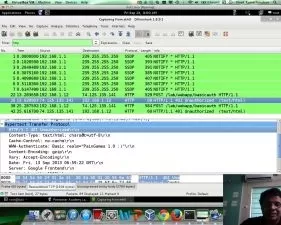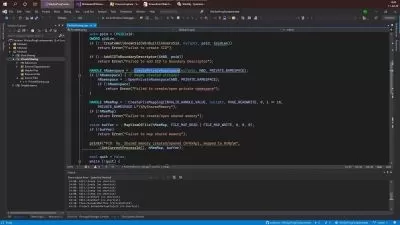Angular Step by Step for beginners
Shivprasad Koirala
8:03:39
Description
This course teaches Angular from basic to advanced level by creating a Customer data entry project.
What You'll Learn?
- Understanding Node NPM, CLI , VS ,Typescript and Webpack build tool.
- Understanding Module and Component architecture in angular. Understanding important properties of component like templateurl , styleurl and selector.
- Understanding configuration files like Angular json , tsconfig json , package json file and semantic versioning.
- Understanding Routing ,router-outlet , routeLink and Lazy loading
- Angular validation using formgroup , formcontrols and validators.
- Creating loosely coupled architecture using DI ( Dependency Injection) and providers.
- Implementing reusable user controls using input , output and event emitters.
- Making http calls , understanding httpclient , http interceptors and fixing double entry problem
- Integrating Angular with visual studio , MVC core and WebAPI.
- Unit testing using Jasmine and Karma.
Who is this for?
More details
Description
This tutorial teaches Angular using a project. So a simple customer screen is taken and around the same the whole course revolves. Remember the best way to learn any technology is by doing a project.
Below are complete details of the course :-
Chapter 1Â :- Node and NPM
Chapter 2Â :- Running first app & Angulr CLI
Chapter 3Â :- VS Code editor.
Chapter 4Â :- TypeScript
Chapter 5Â :- CLI project folder structure
Chapter 6Â :- The config JSON files
Chapter 7Â :- ng serve vs ng build
Chapter 8Â :- Angular the binding framework
Chapter 9Â :- Component and Modules
Chapter 10 :- Expression , Decorators and TemplateURL
Chapter 11 :- Declaration and BootStrap in Modules
Chapter 12 :- The main.ts file for module startup
Chapter 13 :- Index.html and the selector tag
Chapter 14 :- Polyfills
Chapter 15 :- Webpack :- Packaging and deploying
Chapter 16 :- Vendor.js and Runtime.js
Chapter 17 :- Angular File naming Convention
Chapter 18 :- Creating Customer UI
Chapter 19 :- Creating Customer Model
Chapter 20 :- Consuming model in component
Chapter 21 :- ngModel , One way and Two way binding
Chapter 22 :- Expressions
Chapter 23 :- Understanding and Intrepeting Errors
Chapter 24 :- FormsModule
Chapter 25 :- *ngForLoop
Chapter 26 :- package.lock.json and versioning
Chapter 27 :- Using source code of the tutorial.
Chapter 28 :- Thinking Uniform , Thinking Master Pages
Chapter 29:- Creating Angular UI and its components.
Chapter 30 :- Organizing project folders, modules & components.
Chapter 31 :- Masterpage and selector
Chapter 32 :- Grouping components in to Modules.
Chapter 33 :- Understanding UI loading in selector.
Chapter 34 :- Routing and Routing collection
Chapter 35 :- router-outlet and routerLink
Chapter 36 :- RouterModule and loading routes in Angular.
Chapter 37 :- Understanding the flow of Angular with routing.
Chapter 38 :- Performance issues due to eager loading.
Chapter 39 :- Implementing Lazy loading
Chapter 40 :- Dividing project in to self contained Angular modules.
Chapter 41 :- Self contained routes for self contained modules.
Chapter 42 :- loadChildren :- The heart of lazy loading
Chapter 43:- Understanding path structure for folders and loadChildren.
Chapter 44:- forRoot and forChild
Chapter 45:- Multiple Modules , Multiple builds and Multiple outputs.
Chapter 46:- CommonModule for Lazy Loading
Chapter 47:- Seeing the physical separate modules in the "dist" folder.
Chapter 48:- Revising Angular architecture with Lazy routing
Chapter 49 :- Validation object model.
Chapter 50 :- Appropriate place to put validations
Chapter 51 :-Formgroup , FormControl , Validators and FormBuilder
Chapter 52 :- Using Angular validation :- The CCC process.
Chapter 53 :- Creating validations
Chapter 54 :- Applying validations to the UI
Chapter 55 :- Checking validation status
Chapter 56 :- ReactiveForms
Chapter 57 :- ngModelOption standalone
Chapter 58 :- Display errors for individual validations.
Chapter 59 :- The dirty flag.
Chapter 60 :- Centralizing validation code for reusability.
Chapter 61: - Definition of a good architecture
Chapter 62: - Concrete classes and tight coupling
Chapter 63: - Provider - provides things to component.
Chapter 64: - Creating providers: - Provide & UseClass
Chapter 65: - Interfaces issues with Angular DI
Chapter 66: - Finally understanding Dependency Injection
Chapter 67: - Seeing the actual fruits of Dependency Injection
Chapter 68: - Centralized and Conditional DI
Chapter 69: - Injector and tokens - Conditionnal DI
Chapter 70: - Dynamic collections
Chapter 71: - Revising Angular DI architecture
Chapter 72 :- Defining a user control
Chapter 73 :- Interactions :- Input, output and event emitters
Chapter 74 :- Creating user control and its components
Chapter 75 :- Creating user control component and importance of selector
Chapter 76 :- The @input decorator
Chapter 77 :- Stters and custom component naming convention
Chapter 78 :- Creating the Grid UI of the user control
Chapter 79 :- Defining output and event emitters
Chapter 80 :- Understanding the user control flow
Chapter 81 :- Importing and running the user control
Chapter 82 :- Debugging and watching the full flow.
Chapter 83 :- Json-server , the fake webserver
Chapter 84 :- Configuring json-server & db.json.
Chapter 85 :- importing and creating http component object
Chapter 86:-Â Making HTTP Post calls and the subscribe method.
Chapter 87 :- Import HTTP Module at the module level.
Chapter 88 :- Implementing DTO( Data transfer objects)
Chapter 89 :- Lambdas and Callback
Chapter 90 :- Angular HTTP Client.
Chapter 91 :- Using HttpClient
Chapter 92 :Â Simplicity of HttpClient.
Chapter 93:-Â Interceptors in HttpClient
Chapter 94:-Â The double data post
Chapter 95 :- Defining the scope of the tutorial.
Chapter 96 :- Using Angular template and its limitation
Chapter 97 :- Respecting individual build and compilation.
Chapter 98 :- MVC wwwroot folder and Angular
Chapter 99 :- Issues with ng serve and integration
Chapter 100 :- Bootstrapping through MVC
Chapter 101 :- Deployurl concept.
Chapter 102 :- Integrating Webapi with Angular Http
Chapter 103 :- Debugging Angular and MVC
Chapter 104 :- Ahh the camel case and pascal case issue
Chapter 105:- Integrating Grunt with Task runner explorer
Chapter 106 :- Grunt configuration using appsettings.json
Chapter 107 :- Prebuild and Postbuild style
Chapter 108 :- Double tooling VS code and Visual studio
Chapter 109 :- Create new project using ng new command.
Chapter 110 :- Copy the code in to newly created projects.
Chapter 111 :- Run ng serve , fix errors http to httpclient
Chapter 112 :- Test and you are all set
Chapter 113 :- Integration testing vs Unit Testing
Chapter 114 :- Black Box vs White Box
Chapter 115 :- Jasmine and Karma
Chapter 116 :- Understanding Jasmine syntaxes , BDD , Describe and it.
Chapter 117 :- BeforeEach,BeforeAll,AfterEach and AfterAll
Chapter 118 :- The TestBed API
Chapter 119 :- Angular loading flow.
Chapter 120 :- Fixture the baseline.
Chapter 121 :- DebugElement , componentInstance and nativeElement
Chapter 122 :- Assertion - expect , tobeTruthy , toEqual
Chapter 123 :- Synching DOM's DetectChanges.
Chapter 124 :- QuerySelectors.
Chapter 125 :- Running Angular test
Chapter 126 :- Writing a complex unit test for the Customer screen
Who this course is for:
- This course is for people who are new to Angular and want to start from basic and go to advanced level.
This tutorial teaches Angular using a project. So a simple customer screen is taken and around the same the whole course revolves. Remember the best way to learn any technology is by doing a project.
Below are complete details of the course :-
Chapter 1Â :- Node and NPM
Chapter 2Â :- Running first app & Angulr CLI
Chapter 3Â :- VS Code editor.
Chapter 4Â :- TypeScript
Chapter 5Â :- CLI project folder structure
Chapter 6Â :- The config JSON files
Chapter 7Â :- ng serve vs ng build
Chapter 8Â :- Angular the binding framework
Chapter 9Â :- Component and Modules
Chapter 10 :- Expression , Decorators and TemplateURL
Chapter 11 :- Declaration and BootStrap in Modules
Chapter 12 :- The main.ts file for module startup
Chapter 13 :- Index.html and the selector tag
Chapter 14 :- Polyfills
Chapter 15 :- Webpack :- Packaging and deploying
Chapter 16 :- Vendor.js and Runtime.js
Chapter 17 :- Angular File naming Convention
Chapter 18 :- Creating Customer UI
Chapter 19 :- Creating Customer Model
Chapter 20 :- Consuming model in component
Chapter 21 :- ngModel , One way and Two way binding
Chapter 22 :- Expressions
Chapter 23 :- Understanding and Intrepeting Errors
Chapter 24 :- FormsModule
Chapter 25 :- *ngForLoop
Chapter 26 :- package.lock.json and versioning
Chapter 27 :- Using source code of the tutorial.
Chapter 28 :- Thinking Uniform , Thinking Master Pages
Chapter 29:- Creating Angular UI and its components.
Chapter 30 :- Organizing project folders, modules & components.
Chapter 31 :- Masterpage and selector
Chapter 32 :- Grouping components in to Modules.
Chapter 33 :- Understanding UI loading in selector.
Chapter 34 :- Routing and Routing collection
Chapter 35 :- router-outlet and routerLink
Chapter 36 :- RouterModule and loading routes in Angular.
Chapter 37 :- Understanding the flow of Angular with routing.
Chapter 38 :- Performance issues due to eager loading.
Chapter 39 :- Implementing Lazy loading
Chapter 40 :- Dividing project in to self contained Angular modules.
Chapter 41 :- Self contained routes for self contained modules.
Chapter 42 :- loadChildren :- The heart of lazy loading
Chapter 43:- Understanding path structure for folders and loadChildren.
Chapter 44:- forRoot and forChild
Chapter 45:- Multiple Modules , Multiple builds and Multiple outputs.
Chapter 46:- CommonModule for Lazy Loading
Chapter 47:- Seeing the physical separate modules in the "dist" folder.
Chapter 48:- Revising Angular architecture with Lazy routing
Chapter 49 :- Validation object model.
Chapter 50 :- Appropriate place to put validations
Chapter 51 :-Formgroup , FormControl , Validators and FormBuilder
Chapter 52 :- Using Angular validation :- The CCC process.
Chapter 53 :- Creating validations
Chapter 54 :- Applying validations to the UI
Chapter 55 :- Checking validation status
Chapter 56 :- ReactiveForms
Chapter 57 :- ngModelOption standalone
Chapter 58 :- Display errors for individual validations.
Chapter 59 :- The dirty flag.
Chapter 60 :- Centralizing validation code for reusability.
Chapter 61: - Definition of a good architecture
Chapter 62: - Concrete classes and tight coupling
Chapter 63: - Provider - provides things to component.
Chapter 64: - Creating providers: - Provide & UseClass
Chapter 65: - Interfaces issues with Angular DI
Chapter 66: - Finally understanding Dependency Injection
Chapter 67: - Seeing the actual fruits of Dependency Injection
Chapter 68: - Centralized and Conditional DI
Chapter 69: - Injector and tokens - Conditionnal DI
Chapter 70: - Dynamic collections
Chapter 71: - Revising Angular DI architecture
Chapter 72 :- Defining a user control
Chapter 73 :- Interactions :- Input, output and event emitters
Chapter 74 :- Creating user control and its components
Chapter 75 :- Creating user control component and importance of selector
Chapter 76 :- The @input decorator
Chapter 77 :- Stters and custom component naming convention
Chapter 78 :- Creating the Grid UI of the user control
Chapter 79 :- Defining output and event emitters
Chapter 80 :- Understanding the user control flow
Chapter 81 :- Importing and running the user control
Chapter 82 :- Debugging and watching the full flow.
Chapter 83 :- Json-server , the fake webserver
Chapter 84 :- Configuring json-server & db.json.
Chapter 85 :- importing and creating http component object
Chapter 86:-Â Making HTTP Post calls and the subscribe method.
Chapter 87 :- Import HTTP Module at the module level.
Chapter 88 :- Implementing DTO( Data transfer objects)
Chapter 89 :- Lambdas and Callback
Chapter 90 :- Angular HTTP Client.
Chapter 91 :- Using HttpClient
Chapter 92 :Â Simplicity of HttpClient.
Chapter 93:-Â Interceptors in HttpClient
Chapter 94:-Â The double data post
Chapter 95 :- Defining the scope of the tutorial.
Chapter 96 :- Using Angular template and its limitation
Chapter 97 :- Respecting individual build and compilation.
Chapter 98 :- MVC wwwroot folder and Angular
Chapter 99 :- Issues with ng serve and integration
Chapter 100 :- Bootstrapping through MVC
Chapter 101 :- Deployurl concept.
Chapter 102 :- Integrating Webapi with Angular Http
Chapter 103 :- Debugging Angular and MVC
Chapter 104 :- Ahh the camel case and pascal case issue
Chapter 105:- Integrating Grunt with Task runner explorer
Chapter 106 :- Grunt configuration using appsettings.json
Chapter 107 :- Prebuild and Postbuild style
Chapter 108 :- Double tooling VS code and Visual studio
Chapter 109 :- Create new project using ng new command.
Chapter 110 :- Copy the code in to newly created projects.
Chapter 111 :- Run ng serve , fix errors http to httpclient
Chapter 112 :- Test and you are all set
Chapter 113 :- Integration testing vs Unit Testing
Chapter 114 :- Black Box vs White Box
Chapter 115 :- Jasmine and Karma
Chapter 116 :- Understanding Jasmine syntaxes , BDD , Describe and it.
Chapter 117 :- BeforeEach,BeforeAll,AfterEach and AfterAll
Chapter 118 :- The TestBed API
Chapter 119 :- Angular loading flow.
Chapter 120 :- Fixture the baseline.
Chapter 121 :- DebugElement , componentInstance and nativeElement
Chapter 122 :- Assertion - expect , tobeTruthy , toEqual
Chapter 123 :- Synching DOM's DetectChanges.
Chapter 124 :- QuerySelectors.
Chapter 125 :- Running Angular test
Chapter 126 :- Writing a complex unit test for the Customer screen
Who this course is for:
- This course is for people who are new to Angular and want to start from basic and go to advanced level.
User Reviews
Rating
Shivprasad Koirala
Instructor's Courses
Udemy
View courses Udemy- language english
- Training sessions 12
- duration 8:03:39
- English subtitles has
- Release Date 2023/05/05









![[NEW] Master Spring Boot Microservice & Angular K8s CICD AWS](https://traininghub.ir/image/course_pic/19152-x225.webp)








